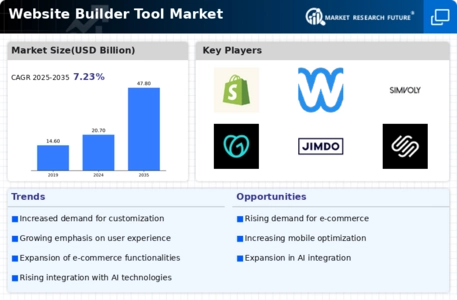E-commerce Growth
The rapid expansion of e-commerce is a major driver for the Global Website Builder Tool Market Industry. As online shopping becomes a preferred choice for consumers, businesses are compelled to establish robust online platforms. Website builders facilitate this transition by providing tools that enable users to create e-commerce sites with integrated payment solutions and inventory management. The market's growth is evident as it is projected to reach 20.7 USD Billion in 2024, with e-commerce functionalities becoming a standard feature in website builders. This trend underscores the importance of website builders in supporting the evolving landscape of online retail.
Increased Mobile Usage
The proliferation of mobile devices significantly influences the Global Website Builder Tool Market Industry. With a growing number of users accessing the internet via smartphones and tablets, website builders are adapting to create mobile-responsive designs. This shift is crucial, as mobile-friendly websites are essential for user engagement and search engine optimization. As businesses strive to reach a broader audience, the demand for mobile-optimized websites is expected to drive the market forward. The anticipated compound annual growth rate of 7.92% from 2025 to 2035 reflects the increasing importance of mobile accessibility in website development.
Market Growth Projections
The Global Website Builder Tool Market Industry is poised for substantial growth, with projections indicating a market size of 20.7 USD Billion in 2024 and an anticipated increase to 47.8 USD Billion by 2035. This growth reflects a compound annual growth rate of 7.92% from 2025 to 2035, driven by various factors such as the rising demand for online presence, technological advancements, and the increasing importance of mobile accessibility. The market's expansion is indicative of the growing reliance on digital platforms for business operations and consumer engagement, highlighting the critical role of website builders in the modern economy.
Technological Advancements
Technological innovations play a pivotal role in shaping the Global Website Builder Tool Market Industry. The integration of artificial intelligence and machine learning into website builders enhances user experience by providing personalized recommendations and automated design features. These advancements not only streamline the website creation process but also improve functionality and design aesthetics. As a result, the market is likely to witness substantial growth, with projections indicating a rise to 47.8 USD Billion by 2035. The continuous evolution of technology ensures that website builders remain competitive and relevant, catering to the ever-changing needs of users.
Shift Towards DIY Solutions
The Global Website Builder Tool Market Industry is witnessing a notable shift towards do-it-yourself (DIY) solutions. As individuals and businesses seek to minimize costs, DIY website builders offer an appealing alternative to hiring professional web developers. These tools empower users to create and manage their websites independently, often with minimal technical knowledge. The market's growth trajectory suggests that this trend will continue, with an expected increase to 47.8 USD Billion by 2035. The appeal of DIY solutions lies in their affordability and user-friendly interfaces, making them attractive to a diverse range of users.
Rising Demand for Online Presence
The Global Website Builder Tool Market Industry experiences a surge in demand as businesses increasingly recognize the necessity of establishing an online presence. In 2024, the market is projected to reach 20.7 USD Billion, driven by small and medium enterprises seeking cost-effective solutions to create professional websites. This trend is likely to continue as digital transformation accelerates across various sectors. The ease of use and accessibility of website builders empower users with limited technical skills to develop their own sites, thereby expanding the market's reach. As more businesses transition online, the demand for website builders is expected to grow significantly.


















